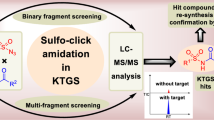Abstract
Success in generating catalytic antibodies as enzyme mimics lies in the strategic design of the transition-state analog (TSA) for the reaction of interest, and careful development of screening processes for the selection of antibodies that are catalysts. Typically, the choice of TSA structure is straightforward, and the criterion for selection in screening is often binding of the TSA to the antibody in a microtiter-plate assay. This article emphasizes the problems of TSA design in complex reactions and the importance of selecting antibodies on the basis of catalysis as well as binding to the TSA. The target reaction is the derivatization of primary amines with naphthalene-2,3-dicarboxaldehyde (NDA) in the presence of cyanideion. The desired outcome is selective catalysis of formation of the fluorescent derivative in preference to nonfluorescent side-products. In the study, TSA design was directed toward the reaction branch leading to the fluorescent product. Here, we describe a microtiter plate-based assay that is capable of detecting antibodies showing catalytic activity atan early stage. Of the antibodies selected, 36% showed no appreciable binding to any of the substrates tested, but did show catalytic activity in deriving one or more of the amino acids screened. In contrast, only two out of 77 clones that showed binding did not show catalysis. Thus, in this complex system, observation of binding is a good predictor of the presence of catalytic activity, and failure to observe binding is a poor predictor of the absence of catalytic activity.
Similar content being viewed by others
References
Tramontano, A., Janda, K., and Lerner, R. A. (1986), Science 234, 1566–1670.
Pollack, S. J., Jacobs, J., and Schultz, P. G. (1986), Science 234, 1570–1573.
Wade, H. and Scanlan, T. S. (1997), Annu. Rev. Biophys. Biomol. Struct. 26, 461–493.
Tawfik, D. S., Zemel, R. R., Arad-Yellin, R., Green, B. S., and Eshhar, Z. (1990), Biochemistry 29 9916–9921.
Tawfik, D. S., Green, B. S., and Eshhar, Z. (1992), Anal. Biochem. 202, 35–39.
Tawfik, D. S., Green, B. S., Chap, R., Sela, M., and Eshhar, Z. (1993), Proc. Natl. Acad. Sci. USA 90, 373–377.
Höllfelder, F., Kirby, A. J., and Tawfik, D. S. (1996), Nature 383, 60–63; Benkovic, S. J. (1996), Nature 383, 23,24.
Barbas, C. F., Heine, A., Zhong, G. F., Hoffmann, T., Gramatikova, S., Bjornestedt, R., List, B., Anderson, J., Stura, E. A., Wilson, I. A., and Lerner, R. A. (1997), Science 278, 2085–2092.
Lane, J. W., Hong, X., and Schwabacher, A. W. (1993), J. Am. Chem. Soc. 115, 2078–2080.
Reymond, J-L., Koch, T., Schröer, J., and Tierney, E. (1996), Proc. Natl. Acad. Sci. USA 93, 4251–4256.
Janda, K. D., Lo, L. C., Lo, C. H. L., Sim, M. M., Wang, R., Wong, C. H., and Lerner, R. A. (1997), Science 275, 945–948.
Gao, C. S., Lavey, B. J., Lo, C. H. L., Datta, A., Wentworth, P., and Janda, K. D. (1998), J. Am. Chem. Soc., 120, 2211–2217.
Pauling, L. (1946), Chem. Eng. News 24, 1375–1377.
deMontigny, P., Stobaugh, J. F., Givens, R. S., Carlson, R. G., Srinivasachar, K., Sternson, L. A., and Higuchi, T. (1987), Anal. Chem. 59, 1096–1101.
Lunte, S. M. and Wong, O. S. (1989), LC-GC. 7, 908–916, Wong, O. S., Sternson, L. A., and Schowen, R. L. (1985), J. Am. Chem. Soc. 107, 6421,6422.
Staros, J. V., Wright, R. W., and Swingle, D. M. (1986), Anal. Biochem. 156, 220–222.
Goding, J. W. (1983), Monoclonal Antibodies: Principles and Practice, Academic Press, NY.
Tijssen, P. (1985), in Laboratory Techniques in Biochemistry and Molecular Biology. Practice and Theory of Immunoassays, Burton, R. H., and van Knippenberg, P. H., eds., Elsevier, Amsterdam.
Jitsukawa, T., Nakajima, S., Sugawara, I., and Watanabe, H. (1989), J. Immunol. Methods 116, 251–257.
Dottavio-Martin, D. and Ravel, J. M. (1976), Anal. Biochem. 87, 562–565.
Habeeb, A. F. S. A. (1966), Anal. Biochem. 14, 328–336.
Galfré, G. and Milstein, C. (1981), Methods Enzymol. 73, 3–47.
DeSilva, B. S. and Wilson, G. S., manuscript in preparation.
Author information
Authors and Affiliations
Rights and permissions
About this article
Cite this article
DeSilva, B.S., Orosz, G., Egodage, K.L. et al. Catalytic antibodies for complex reactions. Appl Biochem Biotechnol 83, 195–208 (2000). https://doi.org/10.1385/ABAB:83:1-3:195
Issue Date:
DOI: https://doi.org/10.1385/ABAB:83:1-3:195




